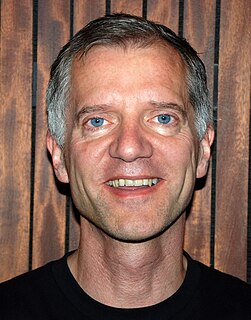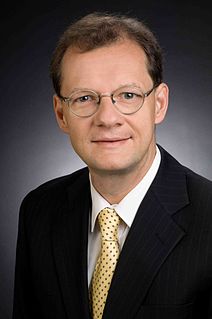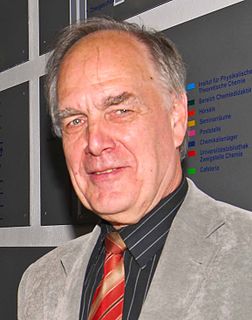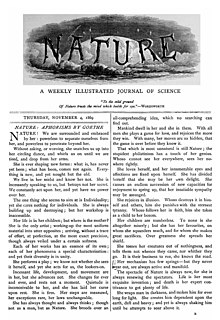Titanic acid is a general name for a family of chemical compounds of the elements titanium, hydrogen, and oxygen, with the general formula [TiOx(OH)4−2x]n. Various simple titanic acids have been claimed, mainly in the older literature. No crystallographic and little spectroscopic support exists for these materials. Some older literature including Brauer's Handbook refers to TiO2 as titanic acid.
Chemometrics is the science of extracting information from chemical systems by data-driven means. Chemometrics is inherently interdisciplinary, using methods frequently employed in core data-analytic disciplines such as multivariate statistics, applied mathematics, and computer science, in order to address problems in chemistry, biochemistry, medicine, biology and chemical engineering. In this way, it mirrors other interdisciplinary fields, such as psychometrics and econometrics.
Devarda's alloy, is an alloy of aluminium (44% – 46%), copper (49% – 51%) and zinc (4% – 6%).

Carl Remigius Fresenius, was a German chemist, known for his studies in analytical chemistry.

Richard Neil Zare is the Marguerite Blake Wilbur Professor in Natural Science and a Professor of Chemistry at Stanford University. Throughout his career, Zare has made a considerable impact in physical chemistry and analytical chemistry, particularly through the development of laser-induced fluorescence (LIF) and the study of chemical reactions at the molecular and nanoscale level. LIF is an extremely sensitive technique with applications ranging from analytical chemistry and molecular biology to astrophysics. One of its applications was the sequencing of the human genome.

Rosocyanine and rubrocurcumin are two red colored materials, which are formed by the reaction between curcumin and borates.

Matthias Mann is a scientist in the area of mass spectrometry and proteomics. Born in Germany he studied mathematics and physics at the University of Göttingen. He received his Ph.D. in 1988 at Yale University where he worked in the group of John Fenn, who was later awarded the Nobel Prize in Chemistry. After a postdoctoral fellowship at the University of Southern Denmark in Odense he became group leader at the European Molecular Biology Laboratory (EMBL) in Heidelberg. Later he went back to Odense as a professor of bioinformatics. Since 2005 he has been a director at the Max Planck Institute of Biochemistry in Munich. In addition, he will also become a principal investigator at the newly founded "Novo Nordisk Foundation Center for Protein Research" in Copenhagen.
The Analytical Sciences Digital Library (ASDL) was founded in 2001 as one of several digital libraries in the National Science Digital Library, funded by the National Science Foundation. The library is a collection of peer-reviewed electronic resources on chemical measurements and instrumentation. The collection also contains materials on active learning and its use for effective instruction in the analytical sciences. The resources in ASDL are freely available and widely used by students, teachers and practitioners of analytical chemistry and its application areas. The site includes a collection of annotated electronic resources catalogued with the Open Archive Initiative and Dublin Core Metadata Initiative, making the collection searchable by any other group that uses these definitions.
The Unscrambler X is a commercial software product for multivariate data analysis, used for calibration of multivariate data which is often in the application of analytical data such as near infrared spectroscopy and Raman spectroscopy, and development of predictive models for use in real-time spectroscopic analysis of materials. The software was originally developed in 1986 by Harald Martens and later by CAMO Software.
The Kendrick mass is defined by setting the mass of a chosen molecular fragment, typically CH2, to an integer value in atomic mass units. It is different from the IUPAC definition, which is based on setting the mass of 12C isotope to exactly 12 u. The Kendrick mass is often used to identify homologous compounds differing only by a number of base units in high resolution mass spectra. This definition of mass was first suggested in 1963 by chemist Edward Kendrick, and it has been adopted by scientists working in the area of high-resolution mass spectrometry, environmental analysis, proteomics, petroleomics, metabolomics, polymer analysis, etc.

Henry M. Fales was an American organic chemist and mass spectrometrist. He authored and co-authored over 350 scientific publications on natural substances and biochemistry and was one of the pioneers in bioanalytical mass spectrometry.
Dr. Paul J. Gemperline is an American analytical chemist and chemometrician. He is a Distinguished Professor of Chemistry at East Carolina University(ECU) located in Greenville, North Carolina and has been the recipient of several scientific awards, including the 2003 Eastern Analytical Symposium Award in Chemometrics. He is author of more than 60 publications in the field of Chemometrics. Dr. Gemperline is currently Dean of the Graduate School at ECU.

Renato Zenobi is a Swiss chemist. He is Professor of Chemistry at ETH Zurich. Throughout his career, Zenobi has made significant contribution to the development of analytical chemistry.

Extractive electrospray ionization (EESI) is a spray-type, ambient ionization source in mass spectrometry that uses two colliding aerosols, one of which is generated by electrospray. In standard EESI, syringe pumps provide the liquids for both an electrospray and a sample spray. In neutral desorption EESI (ND-EESI), the liquid for the sample aerosol is provided by a flow of nitrogen.

Constantin Cândea ; was a Romanian chemist, Professor of Chemistry, Ph.D. Engineer at the Polytechnic University of Timișoara and Rector of Polytechnic University of Timișoara - formerly Polytechnic School of Timișoara between 1946-1947

Bioanalysis is a biweekly peer-reviewed scientific journal established in 2009 and published by Future Science. The editor-in-chief is Neil Spooner. The journal covers the field of bioanalysis, including drug and metabolite assays, chromatography and separation sciences, ligand binding assays, metabolomics, and key detection methods.

Edith Kroupa (1910–1991) was a research chemist who utilized microchemical analysis in the laboratory of Professor A. Franke at the University of Vienna. In 1930, Kroupa and Friedrich Hecht analyzed a sample of radioactive rock from the Huron Claim, Manitoba near Winnipeg, Manitoba, Canada. The team determined the sample to be over 1,725,000,000 years old. Also in 1930, Kroupa and her colleague Friedrich Hecht had discovered triple-weight hydrogen, also known as tritium.
Cynthia Larive is the current Chancellor of University of California, Santa Cruz, and also an American bioanalytical chemist known for developing new instrumentation and analysis techniques involving nuclear magnetic resonance spectroscopy (NMR) and mass spectrometry. She was previously a professor of chemistry and Provost and Executive Vice Chancellor at the University of California, Riverside. She is a fellow of AAAS, IUPAC and ACS, Associate Editor for the ACS journal Analytical Chemistry and editor of the Analytical Sciences Digital Library.

Reiner Salzer is a German chemist and university teacher of Analytical Chemistry at the TU Dresden.














